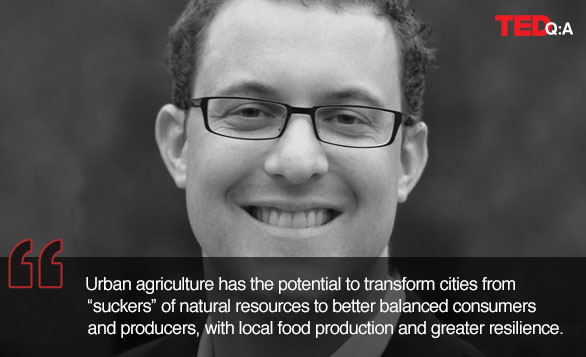 Imagine a city skyline — a jagged line of peaks, drops and plateaus — all filled with rooftop farms. This is the dream of Roman Gaus, CEO of UrbanFarmers, which aims to turn city roof space into a place to grow fresh food and even raise fish.
Imagine a city skyline — a jagged line of peaks, drops and plateaus — all filled with rooftop farms. This is the dream of Roman Gaus, CEO of UrbanFarmers, which aims to turn city roof space into a place to grow fresh food and even raise fish.
Gaus has contributed an essay to the new TED Book, City 2.0: The Habitat of the Future and How to Get There, an anthology born out of The City 2.0 TED Prize and produced in partnership with The Atlantic Cities. In the essay, he writes about the need for better local food sources in cities and the exciting potential of aquaponics.
Here, we ask him a few questions.
So, what is aquaponics and why is it good for cities?
Aquaponics is the combination of commercial fish rearing (aquaculture) and cultivation of plants in water (hydroponics). Aquaponics does not require extensive land use or fertile soil to grow plants. This makes it particularly attractive for urban agriculture, where both space and fertile soil are limited.
You launched your company with the idea that it was time for aquaponics to grow up. What does that mean?
Growing up means becoming a competitive force in the way food is grown in the city.
Aquaponics and its application in urban agriculture is a relatively new phenomenon. The technology and its commercial scale are still in an early stage of development. In order to provide a meaningful contribution toward food security and global awareness on urban resilience, we need to drive solutions that are robust and scalable.
Why is it so important to find large-scale urban food solutions?
In order to meet the global demand for food by 2050, The Food and Agriculture Association of the United Nations estimates that food production needs to double. While access to new arable land can only increase this by 5 percent — and agricultural intensification and efficiencies are peaking — new technologies and solutions are required to help solve the problem.
Urban agriculture has the potential to transform city-dwellers from “suckers” of natural resources to better-balanced consumers and producers — with local food production and greater resilience. This makes a lot of sense for both the planet and the people; it would have a big impact on the way cities are becoming more self-sustainable.
How do you envision aquaponics taking off in the future?
We are getting a lot of requests from all over the world for our solution. Our goal is to provide the tools, services and the brand for urban farming in the city. I think we need both a bottom-up as well as a top-down approach to achieve scale. Of course, community-based initiatives are important, but enterprise-level activities as well as public and governmental support are also required. Why shouldn’t a large supermarket chain or a large public hospital grow on its own rooftops? We see market-based initiatives or “urban farmers” as true entrepreneurs in their cities. The eco-net of financing, technical support and distribution networks needs to be created as well.
City 2.0 is available for Kindle and Nook, as well as through the iBookstore. Or download the TED Books app for your iPad or iPhone. A subscription costs $4.99 a month, and is an all-you-can-read buffet.
The City 2.0 is an online forum that showcase stories and projects for urban innovation, and also doled out 10 grants for thinkers with great ideas for cities throughout 2012. Here, meet 8 of the winners and hear their fascinating ideas »
Comments (2)
Pingback: US Steroids for Sale
Pingback: Food.Farmer.Earth Newsletter: Root Vegetables